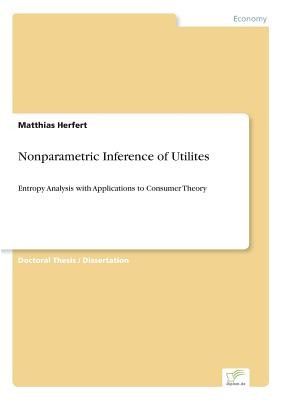
- We will send in 10–14 business days.
- Author: Matthias Herfert
- Publisher: Diplom.de
- Year: 2006
- Pages: 208
- ISBN-10: 3836600102
- ISBN-13: 9783836600101
- Format: 14.8 x 21 x 1.2 cm, softcover
- Language: English
- SAVE -10% with code: EXTRA
Reviews
Description
Inhaltsangabe: Abstract: In Chapter 2, Foundations", we provide a description of selected parts of theories which we believe are helpful to better understand the contribution of this thesis. We start with the presentation of several behavioral hypotheses in preference and utility theory. Next, we describe the basics of inferential statistics and Conjoint Analysis. Then, we describe probabilistic entropy, in addition to that a later established version of it, and its axiomatization as a general inference principle. We conclude Chapter 2 by presenting La Mura's decision-theoretic entropy, a version of entropy as an inference technique for expected utilities. La Mura had developed this connection between probabilistic entropy and expected utilities in his Ph.D. thesis. Based on his work, the initial research objective for this dissertation had been to make his approach applicable to the inference of unique consumer utilities given some observed evidence, having in mind the vast amounts of data that nowadays are available to analysts but still not used very effectively, in order to jointly overcome the limitations of Conjoint Analysis as mentioned above. In the following five chapters you will see that our research has instead resulted in a new method, namely Entropy Analysis, which is not based on expected utility functions but on ordinary utility functions. We close Chapter 2 with a conclusion for the following chapters. In Chapter 3, Entropy Analysis", we derive the new method combining probabilistic cross-entropy and ordinary utility functions. We start by imposing a set of conditions on the inference method. Then, we suggest a normalization of utility functions such that they become formally a probability measure. Finally, we present and prove our main result. In Chapter 4, Irrational Behavior", we present a solution for the problem of how to treat observed irrational" behavior (see Definition 4.1) with Entropy Analysis. This is motivated by two reasons. Fi
EXTRA 10 % discount with code: EXTRA
The promotion ends in 18d.17:01:02
The discount code is valid when purchasing from 10 €. Discounts do not stack.
- Author: Matthias Herfert
- Publisher: Diplom.de
- Year: 2006
- Pages: 208
- ISBN-10: 3836600102
- ISBN-13: 9783836600101
- Format: 14.8 x 21 x 1.2 cm, softcover
- Language: English English
Inhaltsangabe: Abstract: In Chapter 2, Foundations", we provide a description of selected parts of theories which we believe are helpful to better understand the contribution of this thesis. We start with the presentation of several behavioral hypotheses in preference and utility theory. Next, we describe the basics of inferential statistics and Conjoint Analysis. Then, we describe probabilistic entropy, in addition to that a later established version of it, and its axiomatization as a general inference principle. We conclude Chapter 2 by presenting La Mura's decision-theoretic entropy, a version of entropy as an inference technique for expected utilities. La Mura had developed this connection between probabilistic entropy and expected utilities in his Ph.D. thesis. Based on his work, the initial research objective for this dissertation had been to make his approach applicable to the inference of unique consumer utilities given some observed evidence, having in mind the vast amounts of data that nowadays are available to analysts but still not used very effectively, in order to jointly overcome the limitations of Conjoint Analysis as mentioned above. In the following five chapters you will see that our research has instead resulted in a new method, namely Entropy Analysis, which is not based on expected utility functions but on ordinary utility functions. We close Chapter 2 with a conclusion for the following chapters. In Chapter 3, Entropy Analysis", we derive the new method combining probabilistic cross-entropy and ordinary utility functions. We start by imposing a set of conditions on the inference method. Then, we suggest a normalization of utility functions such that they become formally a probability measure. Finally, we present and prove our main result. In Chapter 4, Irrational Behavior", we present a solution for the problem of how to treat observed irrational" behavior (see Definition 4.1) with Entropy Analysis. This is motivated by two reasons. Fi


Reviews